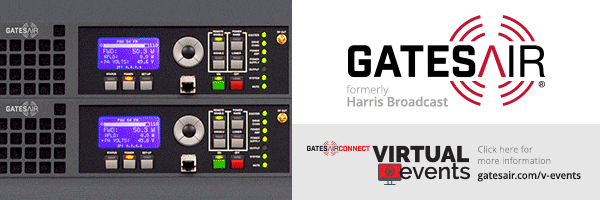In light of several canceled/postponed industry events around the world in 2020, GatesAir is presenting a special schedule of webinars and online events to keep you informed and engaged. This includes new product updates, topical presentations, round tables with special guests, and even “virtual booth meetings” to help personally support their broadcasting needs.
One of the recent webinars in this series was titled FM SFN’s: A Toolkit to Extend Radio Coverage and featured Rich Redmond, President, GatesAir International.
FM broadcasters around the world have long been able to license FM boosters or Single Frequency Networks (SFN) to augment the coverage of their main FM transmitting systems. However, implementation limitations often yielded poor results. Significant advances have been made in FM transmitters, including real-time adaptive precision, time delay control and software coverage planning tools which have closed the gap from paper to reality.
 FM overcame many reception issues that impacted AM broadcasting, however FM is generally a line of sight service. Ideally sited FM’s have very good coverage typically from a tall tower or high mountain top, terrain such as mountains, ridges, or man -made structures such is as city buildings cause shadows impacting usable reception. Sometimes stations attempt to serve a market from outside, commonly known as ‘rimshots’ whose protected contour may encompass the primary city desired but the signal, in reality, is not competitive.
FM overcame many reception issues that impacted AM broadcasting, however FM is generally a line of sight service. Ideally sited FM’s have very good coverage typically from a tall tower or high mountain top, terrain such as mountains, ridges, or man -made structures such is as city buildings cause shadows impacting usable reception. Sometimes stations attempt to serve a market from outside, commonly known as ‘rimshots’ whose protected contour may encompass the primary city desired but the signal, in reality, is not competitive.
On -channel boosters or a single frequency networks to improve coverage due to signal impairment has been available for many years. The concept provides the same content on two (or more) different transmitters, locking to a common reference (typically GPS), creating seamless coverage. In practice, real -world results ranged from very good to the creation of new interference and impaired coverage thus many SFN’s have been turned off after many attempts to “dial it in.” The interference was caused by excessive overlaps of the main FM transmitter and the SFN nodes.
Technology evolution in IP networks and advances in RF device technology have allowed broadcast equipment manufacturers to make significant improvement in the size, cost and flexibility of transmitters and transport products.
In digital networks using multiple low power transmitters in an SFN to create a targeted coverage is commonplace, especially using DVB-T/T2 (television) and DAB/DAB+ (radio) modulations.
GeoBroadcast Solutions pioneered the concept of multiple boosters employing mobile-cellular type antenna patterns to create a focused coverage of the desired area with little signal overlapping the main coverage – MaxxCasting™
GatesAir’s Intraplex SynchroCast® system employs patented technology that provides real time adaptive delay to maintain precision control in an SFN system.
Listening tests conducted by NPR Labs and Towson University revealed for the first time, what listeners would tolerate in terms of misalignment under a wide variety of conditions. This drives the customized software for network design, using real-world data.
GatesAir Flexiva FAX line of solid-state, digitally modulated FM transmitters offer high power density and a very compact footprint. The FAX 3.5K can produce up to 3850 watts in a small 4 rack units of space and weighs a mere 56 lbs./25 kg. The combination of technology, integrated capabilities such as GPS, and the world-class digital exciter well supports SFN boosters in today’s space constrained environments.
Watch the full webinar here.
Subscribe to our flash briefing podcast on these platforms: Acast, Apple iTunes Podcasts, Podtail, Spotify, Google Podcasts, TuneIn, or wherever you get your podcasts.


